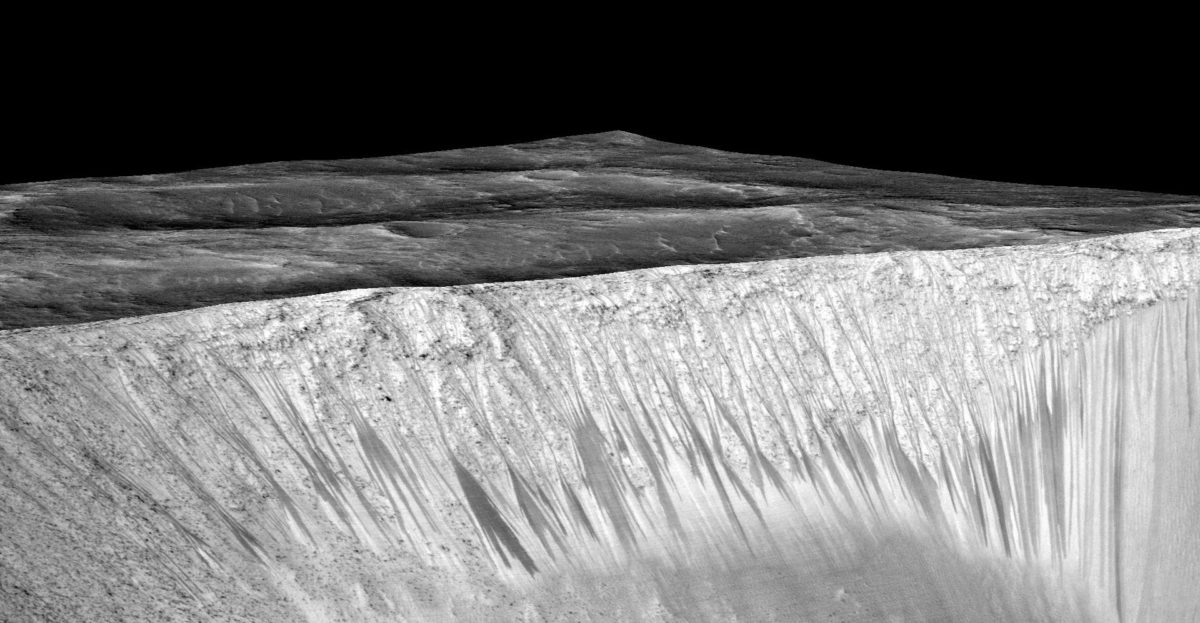Mars, the fourth planet in our Solar System have always been astronomer’s favorite. Thanks to its carved topography, researchers have always suspected that Mars was once home to several rivers, lakes, and perhaps even oceans. There has even been some speculation about the existence of frozen water deep beneath the ground.
Mars is a terrestrial planet with a thin atmosphere, having surface features reminiscent both of the impact craters of the Moon and the volcanoes, valleys, deserts, and polar ice caps of Earth. The rotational period and seasonal cycles of Mars are likewise similar to those of Earth, as is the tilt that produces the seasons.
Being very identical to our Earth, Mars was always a planet to be researched for understanding the Evolution of Earth. It also has been Elon Musk of SpaceX ‘a favorite candidate’ for construction of human colonies.
Early Speculations of Liquid Water in Mars:
Based on the initial observations such as observed periodic variations in light and dark patches, particularly in the polar latitudes, which appeared to be seas and continents; long, dark striations were interpreted by some as irrigation channels for liquid water. These observations, coupled with the fact that Mars has a 24-hour day, led astronomer William Herschel to declare in 1784 that Mars probably offered its inhabitants “a situation in many respects similar to ours.”
By the start of the 20th century, most astronomers recognized that Mars was far colder and drier than Earth. The presence of oceans was no longer accepted, so the paradigm changed to an image of Mars as a “dying” planet with only a meager amount of water. The dark areas, which could be seen to change seasonally, were now thought to be tracts of vegetation.
Percival Lowell thought that there were some underground canals from Poles to mid-Latitudes built by the Martians to irrigate their vegetation. Yet, it was proved false when Gererad Kuiper discovered that the major component available in Martian atmosphere was Carbon Dioxide and tests for Oxygen and Water vapour conduted by Walter Adams and Theodore Dunham provided negative results.
Thus the polar caps which was assumed to have a water in form of ice was then theoretically proved to be composed of CO2 ice because of the planet’s overall low temperature and apparent lack of appreciable water.
Recent Discoveries:
Yet in 2005, radar data revealed the presence of large quantities of water ice at the poles and at mid-latitudes. The Mars rover Spirit sampled chemical compounds containing water molecules in March 2007. The Phoenix lander directly sampled water ice in shallow Martian soil on July 31, 2008.
Moreover in 2013, NASA’s Curiosity rover discovered that Mars’s soil contains between 1.5% and 3% water by mass but attached to other compounds and thus not freely accessible. Also in March 5, 2015 primitive ocean on Mars held more water than Earth’s Arctic Ocean was suggested by NASA scientists who, using ground-based observatories, measured water signatures in the Red Planet’s atmosphere. This finding was derived from the ratio of water and deuterium in the modern Martian atmosphere compared to the ratio found on Earth. Eight times as much deuterium was found at Mars than exists on Earth, suggesting that ancient Mars had significantly higher levels of water. Results from the Curiosity rover had previously found a high ratio of deuterium in Gale Crater, though not significantly high enough to suggest the presence of an ocean. These discoveries led to consider a small amount of water ice present within the dense CO2 ice.
Flowing Water on Mars :
New findings from NASA’s Mars Reconnaissance Orbiter (MRO) provided the strongest evidence yet that liquid water flows intermittently on present-day Mars.
The first indication of the liquid’s presence came in 2011 from high-resolution images captured by the Mars Reconnaissance Orbiter (MRO), which has been orbiting the Red Planet since 2006. They showed dark streaks that appeared to be flowing down the inner walls of the Newton crater in the Red Planet’s Southern Hemisphere. Lujendra Ojha first noticed these puzzling features as a University of Arizona undergraduate student in 2010, using images from the MRO’s High Resolution Imaging Science Experiment (HiRISE).
Ojha and his co-authors interpret the spectral signatures as caused by hydrated minerals called perchlorates. The hydrated salts most consistent with the chemical signatures are likely a mixture of magnesium perchlorate, magnesium chlorate and sodium perchlorate. Some perchlorates have been shown to keep liquids from freezing even when conditions are as cold as minus 94 degrees Fahrenheit (minus 70 Celsius). On Earth, naturally produced perchlorates are concentrated in deserts, and some types of perchlorates can be used as rocket propellant.
The perchlorates on Mars are forming the streaks, called recurring slope lineae (RSL), on the Martian slopes during the planet’s warm season, when temperatures climb above -10 degrees Fahrenheit. The streaks then disappear during the cold season.
Perchlorates have previously been seen on Mars. NASA’s Phoenix lander and Curiosity rover both found them in the planet’s soil, and some scientists believe that the Viking missions in the 1970s measured signatures of these salts.
“This means the water on Mars is briny, rather than pure. It makes sense, because salts lower the freezing point of water. Even if RSL are slightly underground, where it’s even colder than the surface temperature, the salts would keep the water in a liquid form and allow it to creep down Martian slopes.” Ojha said in a statement.
The Second big announcement came on October 8, 2015 when the Curiosity rover has found geological evidence that lakes of liquid water existed in the base or slopes of Mount Sharp situated on the Gale crater in Mars, 3.5 billion years ago.
Curiosity has been romping around the Gale Crater looking for clues left behind in the sedimentary rocks. These tightly packed layers of rock, which formed from the steady accumulations of tiny sediment grains, provide an historical snapshot of the surface. And as we know from studying sedimentary rocks on Earth, these rocks often include evidence of life, such as fossils and microscopic biosignatures.
Images of the sediments show that gravel and sand that eroded off the northern wall of the crater were carried south in shallow streams that formed deltas at the boundary of an ancient lake. Although the lakes were not permanent, some may have existed for 10,000 years.
As Gale Crater’s northern crater wall and rim gradually eroded, gravel and sand were transported southward in shallow streams. Over the course of time, these stream deposits moved progressively closer toward the crater’s interior, where it transformed into finer grains downstream. In other words, the researchers discovered traces of ancient river deltas. These deltas represented the boundary of an ancient Martian lake where fine, mud-sized sediments had once accumulated.
John Grotzinger, a researcher at Caltech and chief scientist for the rover comments “The paradox is that where today there was a mountain, there was once a basin.”
Future Plans and Missions :
As of now, scientists are not sure where the water is sourced from. They hypothesize that it may be seeping up from underground ice or aquifers, or condensing out of the thin Martian atmosphere. Though the mystery could easily be solved with a water sample, it is not possible even though NASA’s Mars Curiosity Rover is just about 30 miles away from the source.
That’s because the Outer Space Treaty of 1967 prevents any nation from getting too close to a water source on another planet, for fear that it might contaminate it with microbes from Earth.
The one hope scientists have of getting near the liquid is with the help of the organic molecule analyzer that the European Space Agency plans to send on its 2018 ExoMars mission. While its primary purpose is to look for evidence of life on the Red Planet, it may be able to get near enough to the water flow and collect samples if complete sterilization can be guaranteed. Meanwhile, researchers have marked the areas where the water seems to be coming from as targets for future potential human mission sites.






ONE COMMENT